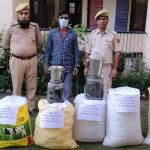Dengue fever is a viral infection transmitted by two specific types of mosquitoes, the Aedes aegypti and the Aedes albopictus species. The global incidence of dengue has grown dramatically during recent years. As per a recent global estimate, provided by the World Health Organization – as many as 100 to 400 million new cases occur every year across the world and as many as 500,000 people, mostly children, develop the more severe form of dengue fever that require hospitalization. Sadly, about 13,000 of those people die.
The problem is becoming a growing public health concern in India as well. In Jammu and Kashmir UT, there is emergence of dengue infection to a certain extent. As per experts in medical sciences, the primary goal of treatment is on supportive measures with emphasis on recognizing the more severe forms of the infection in order to promptly seek medical attention.
Signs and Symptoms
Once bitten by a mosquito that is carrying dengue fever, the average time for symptoms to begin is four to seven days. While the average incubation period is from four to seven days, one may experience symptoms as early as three days or as late as two weeks after being bitten.
A high fever is the first symptom to appear. Fevers with dengue fever are high, ranging from 102°F to 105°F (38.9°C to 40.6°C). The high fever lasts for two to seven days, returns to normal or even a little below normal, then can rebound. One may develop a high fever again that can last for several more days.
The initial symptoms that develop after the fever begins are generally non-specific, and are described as flu-like in nature. Common symptoms that occur after the fever begins include severe frontal headache, pain behind the eyes, severe joint and muscle pain, nausea and vomiting, fatigue, and a rash. Dengue fever was once called “break-bone fever” due to the severe pain that is sometimes felt in the joints and muscles.
Other common symptoms caused by the virus can create hemodynamic changes, or changes that alter the flow of blood in the body. Examples of blood flow changes seen with dengue fever include nosebleeds, bleeding from the gums, and areas of bruising. Additional symptoms related to changes in blood flow may be evident by reddened areas in the eyes and a sore or inflamed throat.
The other warning signs indicating one’s body may be having trouble maintaining the integrity of blood vessels include the following: persistent nausea and vomiting – vomiting up blood or coffee-ground material, blood in urine, abdominal pain, difficulty breathing.
The rash usually begins three to four days after one developed the fever, can get better for one to two days, but then can come back. The initial rash often involves the facial area, and can appear as flushed skin or spotty and reddened areas. The rash does not itch. The second rash begins on the trunk area, then spreads to the face, the arms, and the legs. The second rash can last from two to three days. In some cases, a rash that is made of small dots, called petechiae, may appear anywhere on the body as the fever subsides. Other rashes that sometimes occur include an itchy rash on the palms of the hands and the soles of the feet.
Usually signs and symptoms would suffice in establishing diagnosis. However, dengue testing and changes in platelet count can often be checked to help verify the diagnosis. People that are infected with dengue fever have often lower than normal platelet counts.
Possible Complications
The symptoms may persist beyond seven days, involving problems with continued vomiting, vomiting up blood, severe abdominal pain, difficulty breathing, purplish areas under the skin similar to bruises, and continued problems with nosebleeds or bleeding gums, leading to ‘dengue hemorrhagic fever’– a serious and life-threatening medical condition.
The tiniest blood vessels in one’s body, become more permeable, or leak. The leaky capillaries allow fluid to leak from blood vessels and accumulate in chest and abdominal cavity, causing conditions medically termed as ascites and pleural effusions.
Dengue shock syndrome, another complicated entity is recognized by early symptoms that include a decrease in appetite, continued fever, continued vomiting, and persistent symptoms associated with dengue fever. The maximum risk of shock is between the third and seventh day of illness. Dengue shock syndrome can be fatal. Moreover, the person may experience brain disease, loss of brain function, liver damage, or seizures.
Treating Dengue Fever
While there is no specific treatment for dengue fever, the risks of developing bleeding problems caused by the infection warrant medical care. While most people recover from dengue fever in about two weeks with general supportive care, many people, especially adults, continue to feel tired, and somewhat depressed, for several weeks to months following an infection with dengue fever.
The most common methods of treating dengue fever is to take steps to allow one’s body to heal and getting plenty of bed rest, drinking lots of fluids and taking medications to control fever. Treatment for dengue shock syndrome will include controlling the loss of blood, fluid replacement, attempts to establish a normal blood pressure, oxygen, and possibly a transfusion to restore platelets and provide fresh blood to vital organs.
Preventing Dengue Fever
- Mosquitoes that carry dengue fever most often feed during the day, usually in the early morning and late afternoon hours. Staying indoors during those times, keeping the air conditioning on, and keeping screen doors and windows closed. Travelling during the times of day when the mosquitoes are less active.
- Taking steps to cover one’s skin. Wearing full-bodied clothing. Trying to wear long sleeves, long pants, socks and shoes, and even work gloves, when one needs to be outside during the times of day when the mosquitoes are more active. Sleeping under mosquito netting.
- Mosquitoes that carry dengue fever are most often found close to dwellings. They like to breed in water that is held in artificial containers, like gallon drums, flower pots, pet dishes, or old tires. Getting rid of any standing water containers that are not needed. Checking for hidden sources of standing water–clogged drains or gutters, wells, manholes, and septic tanks may have areas of standing water. Cleaning these areas or repairing them so that they no longer hold unwanted water.
- Eliminating containers that hold standing water around or near the outside of one’s home. Cleaning flower pot saucers, birdbaths, fountains, and pet dishes at least once a week to get rid of any larva. Maintaining swimming pools and put mosquito-eating fish in small ponds. Making sure doors and windows have screens that fit tightly, and all doors and windows close properly.
(Author is a Physician/Diabetes Expert, Member American College of Physicians (USA) and Member RSSDI. Feedback: [email protected])








